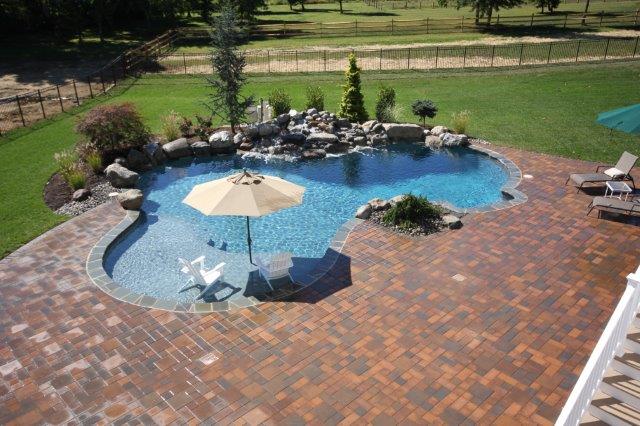Let`s look at the in ground Vinyl liner pool first. This type of pool is very affordable and can be completed rather quickly (approximately 4 to 6 weeks). The shape of the pool is constructed from monolithically poured concrete with the floor of the pool being vermiculite. A vinyl liner is installed within this shell. One of the nicest things about the liner pool is the softness/smoothness of the liner. If you have ever had the opportunity to swim in one of these pools you would come to learn that there is no surface available in a shotcrete pool that would be nearly as smooth. Since these surfaces tend to not be as porous as a plaster finish on a shotcrete pool, this type of pool actually uses less sanitizer (30% less). The most important thing to understand is that the liner is what actually holds the water in this type of pool. Therefore it is very important to avoid puncturing the liner with any form of sharp object. On average, liners need replacing every 12-15 years. Cost of doing so can range between 3-5 thousand dollars depending on the size of the pool. One other consideration is the project site. Proper drainage is of great importance, a poorly draining backyard due to storm water runoff will pose potential problems for a vinyl liner. Resulting in a condition called “floating” which is where the runoff water has permeated behind the vinyl liner and caused it to float up off the pool floor and away from the side walls. Therefore overcoming potential drainage problems should be first and foremost prior to landscaping. Vinyl liner pool construction is a very popular choice for budget minded individuals and if installed correctly will surely bring years of enjoyment to you and your family.
 Shotcrete pools can have a great deal more design applications than Vinyl pools and is limited only by your budget. Again when properly installed they are very nice. With a shotcrete pool the structure is actually steel reinforced while the interior is usually plaster or quartz. This interior surface is porous, therefore if chemicals get out of balance then the plaster can become rough. What happens is over time some of the cement in the plaster mix can become “etched” resulting in an abrasive finish. This can be like sand paper on your toes. So it`s very important to maintain good water chemistry. Should this condition arise you will need to re-plaster the pool at an average expense of 6-8 thousand dollars. The good news is if properly maintained the plaster can last as long as 20 years. What we have seen is more of an average of 15 years before re-plastering. You can opt to upgrade to a pebble finish, although not as smooth as plaster it is more resilient. Shotcrete pools utilize ceramic tile on the water line as well as some form of stone or brick coping. Due to this as well as the labor involved in building a shotcrete pool you can anticipate investing 30-40 percent more than that of Vinyl pools. Also understand that shotcrete pools take the longest time to build, averaging 8-10 weeks or longer. On the plus side structurally, when installed properly, shotcrete pools are the strongest. Also this type of pool can be installed in almost any soil condition from sandy to rocky. Another plus is most Realtors and potential home buyers perceive shotcrete pools as a more permanent structure and will usually value it more.
Shotcrete pools can have a great deal more design applications than Vinyl pools and is limited only by your budget. Again when properly installed they are very nice. With a shotcrete pool the structure is actually steel reinforced while the interior is usually plaster or quartz. This interior surface is porous, therefore if chemicals get out of balance then the plaster can become rough. What happens is over time some of the cement in the plaster mix can become “etched” resulting in an abrasive finish. This can be like sand paper on your toes. So it`s very important to maintain good water chemistry. Should this condition arise you will need to re-plaster the pool at an average expense of 6-8 thousand dollars. The good news is if properly maintained the plaster can last as long as 20 years. What we have seen is more of an average of 15 years before re-plastering. You can opt to upgrade to a pebble finish, although not as smooth as plaster it is more resilient. Shotcrete pools utilize ceramic tile on the water line as well as some form of stone or brick coping. Due to this as well as the labor involved in building a shotcrete pool you can anticipate investing 30-40 percent more than that of Vinyl pools. Also understand that shotcrete pools take the longest time to build, averaging 8-10 weeks or longer. On the plus side structurally, when installed properly, shotcrete pools are the strongest. Also this type of pool can be installed in almost any soil condition from sandy to rocky. Another plus is most Realtors and potential home buyers perceive shotcrete pools as a more permanent structure and will usually value it more.
I hope that you find some of this information helpful in determining what construction type best suits your needs. Whether you are most interested in Vinyl or Shotcrete understand this. The greatest importance is not the construction type but the contractor that you choose. This is where the greatest risk lies, so be sure to pick a reputable one!
Bernie…. Budd`s Pools

